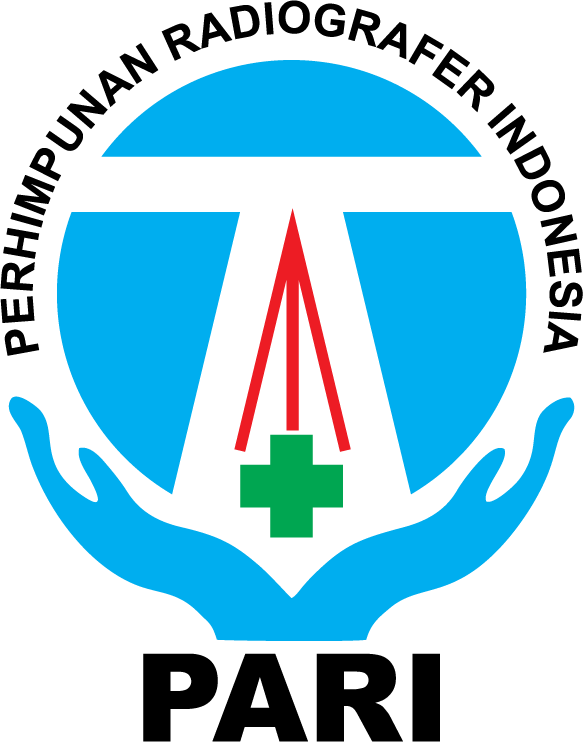Analisis Prosedur Pemeriksaan Magnetic Resonance Spectroscopy (MRS) Pada Kasus Tumor Otak
Abstract
Background: Magnetic Resonance Spectroscopy (MRS) is a method for measuring or assessing changes in the chemical elements of brain tissue in abnormalities such as tumours, stroke, epilepsy, metabolic disorder, infections, and neurodegenerative disease. MRS sequences require techniques to suppress fat and water signals, so the value of metabolic elements such as NAA< Choline, Creatine, Lipids, and Lactate not been covered by fat and water. The peak amplitude of metabolic elements in MRS depends on the parameter used in the MRS sequences especially TE. Some studies suggest that variation and combinations of TE can provide more complete information on metabolite element, and can even be used to grading tumour stages.
Methods: Type of this research is a qualitative study with an observational approach. Data collection was conducted in June 2019 at Radiology Department with observation method, unstructured interview, and documentation related to Magnetic Resonance Spectroscopy procedures. Data processing and analysis are carried out descriptively related to the result of observation, interview, and documentation.
Results: The Head MR Spectroscopy examination procedure is a follow-up procedure of contrast MRI of the head. The main metabolite elements assessed on MRS are NAA, Choline, and Creatine, while those calculated and analyzed are the Area Under Cover (AUC) Integrals which are a collection of NAA and Choline signals. MRS sequences use Multi Voxel Spectroscopy (MVS). Chemical Shift Imaging (CSI) is used to suppress fat and water signals. TE parameter used in MRS sequences is only intermediate 135 ms.
Keywords
Full Text:
PDFReferences
Joshua M., Mahvish Dawood, Mohamed IF, Vijay PB., et al. Magnetic Resonance Spectroscopy : principles and Technique : Lessons for Clinicians. Journal of Clinical and Experimental Geaptology. 2015:vol 5 No 4:320-328
Alena Horska, Peter B. Imaging of Brain Tumor : MR Spectroscopy and Metabolic Imaging. Neuroimaging Clin N.Am. 2010;20(3);293-310
Radwa KAmel, Afaf Abdel, Amr Mohammed, et al. Role of Magnetic Resonance Spectroscopy in Grading of Primary Brain Tumors. 2016;(47):577-584
Carles Majos, Margarida Julia-Sape, Julio Alonso, et al. Brain Tumor Classification by Proton MR Spectroscopy : Comparison of Diagnostic Accuracy at Short and Long TE. American Journal of Neuroradioloy. 2004:25:1696-1704
Barker PB. N-Acetyl Aspartate- a Neural Marker?. Ann Neural. 2001;49(4):423-424
Gupta RK, Cloughesy IF, Sinha U, et al. Relationship between Choline Magnetic Resonance Spectroscopy, Apparent Diffusion Coefficient and Quantitative Histopathology in Human Glioma. J Neurooncol. 2000;50(3):215-226
Herolz K, Heindel W, Luyten PR, et al. In Vivo Imaging of Glucose Consumption and Lactate Concentration in Human Gliomas. Ann Neurol. 1992;31(3):319-327
Hamsini BC, Bhavana NR, Sankar N, et al. Clinical Application of MR Spectroscopy in Identifying Biochemical Composition of the Intracranial Pathologies. New Developments in Neurotransmission Research. 2018
John R Hesselin. Fundamentals of MR Specroscopy. 2014
Sastrosudarmo Wh. 2010. Kanker The Silent Killer. Jakarta : Garda Media
DOI: https://doi.org/10.31983/jimed.v6i2.5823
Article Metrics
Refbacks
- There are currently no refbacks.
JURNAL IMEJING DIAGNOSTIK by http://ejournal.poltekkes-smg.ac.id/ojs/index.php/jimed is licensed under a Creative Commons Attribution-ShareAlike 4.0 International License.

.png)
.png)
.png)
.png)
.png)
.png)
.png)











